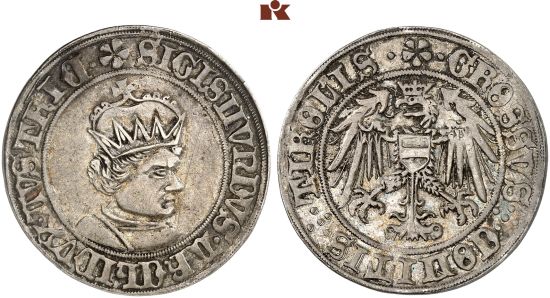Austria (1482-96) pfundner
This specimen was lot 290 in Künker sale 400 (Berlin, February 2024), where it sold for €5,000 (about US$6,487 including buyer's fees). The catalog description[1] noted,
"TIROL, GRAFSCHAFT, Erzherzog Sigismund, der Münzreiche, 1446-1496. Pfundner o. J. Hall. RR Attraktives Exemplar mit hübscher Patina, winz Kratzer auf der Vorderseite, fast vorzüglich. (Austria, county of Tirol, archduke Sigismund the Rich, 1446-96, undated pfundner, Hall mint. Very rare, attractive example with handsome patina, minor scratches on the obverse, about extremely fine.)
Erzherzog Sigismund, *26.10.1427 Innsbruck, †04.03.1496 Innsbruck, war der Sohn Friedrichs IV. der durch permanente Geldnot den Beinamen "mit der leeren Tasche" erhielt. Erst 1446 wurde Sigismund aus der Vormundschaft Kaiser Friedrichs III. entlassen. Seit dem 8. Dezember führte er den Titel Erzherzog. Er schloß die Münzstätte in Meran und eröffnete die Münzstätte Hall bei Innsbruck, die sich rasch zu einer der modernsten und produktivsten Münzstätten weltweit entwickeln sollte. Durch die reichen Silberbergwerke Tirols (vor allem in Schwaz) wurde seine umfassende Geldreform ermöglicht, die ihm den Beinamen "der Münzreiche" einbrachte. Am 16. März 1490 überließ er Tirol und die Vorlande seinem Vetter Maximilian I. (Archduke Sigismund, 1427-96, born and died at Innsbruck, was the son of Frederick IV, who was nicknamed "with the empty pocket" due to constant lack of money. It was not until 1446 that Sigismund was released from the guardianship of Emperor Frederick III. Since December 8th he held the title of Archduke. He closed the mint in Merano and opened the Hall mint near Innsbruck, which would quickly develop into one of the most modern and productive mints in the world. The rich silver mines in Tyrol (especially in Schwaz) made his comprehensive monetary reform possible, which earned him the nickname “the rich in coins”. On March 16, 1490 he left Tyrol and the foothills to his cousin Maximilian I.)"
The pfundner was twelve kreuzer or one fifth of a guldiner or thaler. It was abandoned in favor of the six kreuzer after Sigismund's death in 1496.
Recorded mintage: unknown.
Specification: 6.31 g, silver, 28 mm diameter, this specimen 6.34 g.
Catalog reference: M./T. 57.
- Heinz Moser and Heinz Tursky, Die Munzstatte Hall in Tirol, 2 vols. Innsbruck: Verlag Dr Rudolf Erhad, 1981.
- [1]Künker, Fritz Rudolf, Horst-Rudiger Künker, Ulrich Künker and Andreas Kaiser, Katalog 400: Selected löser of the Dukes of Guelph from the Friedrich Popken Collection | Numismatic treasures from the Medieval and Modern Times, a. o. "multiple portraits" from a Westphalian private collection, Osnabrück: Fritz Rudolf Künker GmbH & Co., AG, 2024.
Link to:
